
A missile is an airborne ranged weapon capable of self-propelled flight aided usually by a propellant, jet engine or rocket motor.

A ballistic missile (BM) is a type of missile that uses projectile motion to deliver warheads on a target. These weapons are powered only during relatively brief periods—most of the flight is unpowered. Short-range ballistic missiles (SRBM) typically stay within the Earth's atmosphere, while most larger missiles travel outside the atmosphere. The type of ballistic missile with the greatest range is an intercontinental ballistic missile (ICBM). The largest ICBMs are capable of full orbital flight.
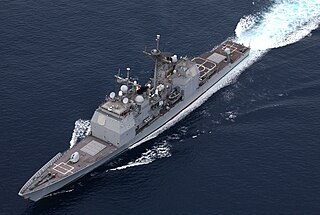
The Aegis Combat System is an American integrated naval weapons system, which uses computers and radars to track and guide weapons to destroy enemy targets. It was developed by the Missile and Surface Radar Division of RCA, and it is now produced by Lockheed Martin.

The Shahab-3 is a family of liquid-fueled ballistic missiles developed by Iran, under the IRGC, and based upon the North Korean Nodong-1/A and Nodong-B missiles. The Shahab-3 family has a range of 800-1,000 kilometres (620 mi). It was tested from 1998 to 2003 and added to the military arsenal on 7 July 2003, with an official unveiling by Ayatollah Khamenei on July 20. It has an estimated accuracy of about 2,500m CEP. According to the IAEA, Iran in the early 2000s may have explored various fuzing, arming and firing systems to make the Shahab-3 more capable of reliably delivering a nuclear warhead.
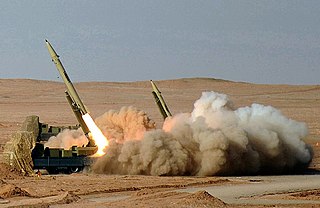
The Fateh-110, also known as NP-110 is an Iranian solid-fueled surface-to-surface ballistic missile produced by Iran's Aerospace Industries Organization since 2002. It is single-stage, road-mobile and can carry a high-explosive warhead of up to 500 kg. Four different versions, the Fateh-110A, 110B, 110D-1 and Fateh-E Mobin were developed with varying accuracy. The latest version, first shown to the public in August 2018 reportedly has a range of 300 km is reportedly more accurate than previous versions.
The Islamic Revolutionary Guard Corps Aerospace Force, officially known as the Islamic Revolutionary Guard Corps Air and Space Force, is the strategic missile, air, and space force of the Islamic Revolutionary Guard Corps (IRGC). It was renamed from the IRGC Air Force to the IRGC Aerospace Force in 2009.

Hyunmoo is a series of South Korean ballistic and cruise missiles developed by the Agency for Defense Development (ADD) and manufactured by Hanwha and LIG Nex1.

The Weishi family of multiple rocket launcher systems were mainly developed by Sichuan Academy of Aerospace Technology in the central province of Sichuan, China at Chengdu city. The systems include the 302 mm (11.9 in) WS-1, the improved 302 mm (11.9 in) WS-1B, the 122 mm (4.8 in) WS-1E, the 400 mm (16 in) WS-2, as well as many other models. The WS-1 series weapon system did not enter PLA service and has order from Thailand. The WS-2 may finally see PLA service in the future. It's worth noticing that although sharing the same name, there are other developers for different models of Weishi series multiple rocket launchers (MRL) other than the primary developer SCAIC.
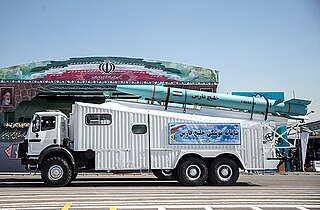
An anti-ship ballistic missile (ASBM) is a military ballistic missile system designed to hit a warship at sea.
The B-611 is a Chinese solid-fuelled short-range ballistic missile (SRBM) developed by China Precision Machinery Import-Export Corporation (CPMIEC). The missile has a maximum range of 150–400 km (93–249 mi).
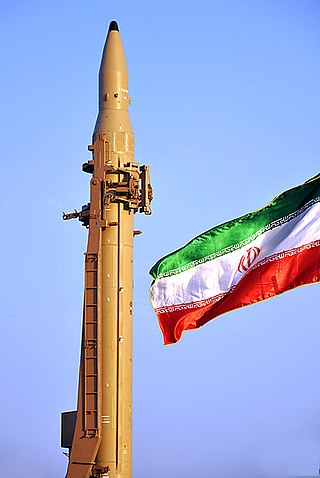
The Qiam 1 is a short-range ballistic missile designed and built by Iran. It was developed from the Iranian Shahab-2, a licensed copy of the North Korean Hwasong-6, all of which are versions of the Soviet Scud-C missile. The Qiam 1 entered service in 2010, with a range of 800 km (500 mi) and 100 m (330 ft) (CEP) accuracy.

Khalij-e Fars is an Iranian single-stage solid-propellant, supersonic anti-ship quasi ballistic missile with a range of 300 km based on the Fateh-110 missile. It is equipped with a 650 kg explosive warhead and an interception evading guidance system.
Iran has been testing and producing missiles since the war with Iraq to increase its military capabilities.". there have been a series of missile tests performed by Iran:

Fateh-313, an Iranian solid-fuel short-range ballistic missile, was unveiled on 21 August 2015. The Fateh-313 missile is the newest model within the Fateh missiles family. It is almost identical to the previous generation, the Fateh-110, but utilizes a new composite fuel and body. These changes increased the range to 500 km, from the Fateh-110's 300 km. Iran’s Defense Ministry plans to mass produce the missile.
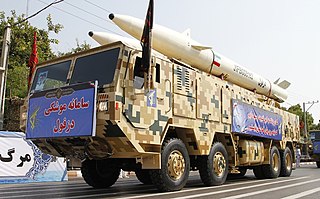
Dezful is a medium range ballistic missile (MRBM) developed by Iran and unveiled in February 2019 in an underground missile factory. The Iranian armed forces said that the missile has a range of over 1,000 kilometers. It carries a 600 or 700 kg warhead and has a CEP of 5 meters. The missile can attain the speed of Mach 7. Brigadier General Amir Ali Hajizadeh said this is an upgrade on the older Zolfaghar model, that had a range of 700 kilometers.
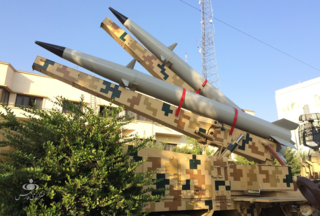
Raad-500 missile is an Iranian SRBM/Tactical ballistic missile which is equipped with a progressive composite engine that is dubbed as "Zohair ". Raad-500 means "Thunder 500", and it was designed by halving the weight of the previous Iranian missile (Fateh-110) whose body was made from metal; whereas the range of this new Iranian ballistic missile increased two hundred kilometers more than Fateh-110), and its final range is 500 kilometers.
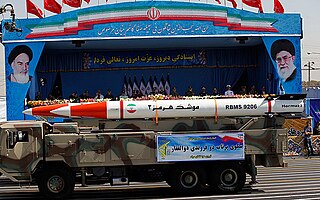
Hormuz-2 (missile) is an Iranian naval (strike) ballistic missile which is able to hit floating-targets at sea with high accuracy. The range of this Iranian missile is approximately 300 km. It was revealed in a defense exhibition on 11 May 2014 and is believed to be an Anti-radiation derivative of Fateh-110 tactical ballistic missile having Terminal guidance instead of Electro-Optical guidance.

Fath-360, also known as BM-120, is an Iranian short-range satellite-guided tactical ballistic missile announced on the Islamic Republic of Iran Army Day, April 18, 2022. They are built by the Aerospace Industries Organization (AIO).















